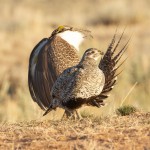 Here are the details regarding my upcoming Mount Diablo Audubon Society talk. This will be at the October monthly meeting (Thursday, Oct 4) at the normal location- Camellia room at the Gardens at Heather Farms in Walnut Creek. The meeting starts at 7PM, and the seminar should start around 8. This will be a sage-grouse talk, featuring how they make sound, and some of the conservation work headed up by Jessica and Gail.
Here are the details regarding my upcoming Mount Diablo Audubon Society talk. This will be at the October monthly meeting (Thursday, Oct 4) at the normal location- Camellia room at the Gardens at Heather Farms in Walnut Creek. The meeting starts at 7PM, and the seminar should start around 8. This will be a sage-grouse talk, featuring how they make sound, and some of the conservation work headed up by Jessica and Gail.
I also received a follow up email regarding my 16 November talk at CCSF. Apparently I have the option of having my talk recorded, and also having the recording broadcast on community access television. Can’t help but think about Wayne’s World now!
